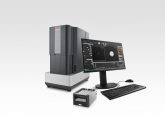Novel interferometric technique enables a closer look at biomacromolecules

Researchers from the Institute of Biophysics of the Chinese Academy of Sciences (Beijing, China) have developed a novel interferometric single-molecule localization microscopy process that improves the resolution of single-molecule localization microscopy (SMLM). The research, published in Nature Methods could extend the application of SMLM in biomacromolecule research.
Until recently it has been difficult for researchers to improve upon the single-molecule lateral localization precision to a molecular scale of approximately 2nm for high-throughput nanostructure imaging. The novel interferometric technique, termed Repetitive Optical Selective Exposure (ROSE), utilizes six different direction and phase interference fringes. Each fluorescence molecule is located by the intensities of multiple excitation patterns of an interference fringe. This has provided a twofold improvement in localization precision, pushing the resolution of SMLM to less than 3nm (~1nm localization precision).
The researchers designed three lattice grids with DNA origami structures of different sizes with 5nm, 10nm and 20nm point-to-point spacing to verify the performance of ROSE. When compared to conventional centroid fitting, both methods could resolve the 20nm structure at the same photon budget. ROSE could also clearly resolve the 10nm structure, which could not be resolved by conventional centroid fitting. Additionally, the researchers demonstrated that ROSE could resolve 5nm structures of a resolution of approximately 3nm over a 25x25mm2 field of view, pushing the resolving power of SMLM to the molecular scale.
In analyzing cellular nanostructures, ROSE demonstrated advantages in resolving the hollow structure of single microtubule filaments, actin filaments and small clathrin-coated pits. The Fourier ring correlation analysis demonstrated that when compared with the centroid fitting method, ROSE was capable of a twofold improvement in final resolution. ROSE also has the capability to be extended to 3D nanometer-scale imaging by introducing additional excitation patterns along the axial direction.
The researchers hope that this method could extend the application of SMLM in biomacromolecule dynamic analysis and structural studies at the molecular scale.
Sources: Gu L, Li Y, Zhang S et al. Molecular resolution imaging by repetitive optical selective exposure. Nat methods. doi:10.1038/s41592-019-0544-2 (2019)(Epub ahead of print); https://phys.org/news/2019-09-interferometric-single-molecule-localization-microscopy.html



